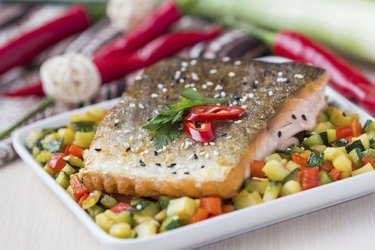
Of all macronutrients, protein is the most satiating. Lean sources of protein, such as chicken and fish, should be an important component of any weight-loss plan. A serving of chicken or fish contains between 22 and 35 g or protein. By making you feel fuller, protein can help you decrease the number of calories you consume and make it easier to stick to your diet by reducing hunger and cravings.
Step 1
Choose a 3- to 4-oz., 90 to 120 g, portion. Portion control is key in any weight-loss programs. Your serving of chicken or fish should be about the size of the palm of your hand, which corresponds to 3 to 4 oz. cooked for most people. Use a scale if possible to be more accurate and stay within your calorie target. A serving of 3 to 4 oz. of chicken or fish provides 105 to 215 calories, according to the U.S. Department of Agriculture's National Nutrient Database. Chicken breast and white fish are closer to the lower end of the range, whereas cold-water fatty fish, such as trout, salmon and herring, are closer to the upper range. Cold-water fatty fish may contain more calories, but they also contain an abundance of health-protective omega-3 fatty acids; so do not eliminate them. If you opt for a large, 8-oz. serving of fish or chicken, you could be consuming more than 400 calories.
Video of the Day
Step 2
Use a low-fat cooking method, such as baking, broiling, barbecuing or light stir-frying. Use no more than 1 to 2 tsp. of good quality fat, such as olive or canola oil, to facilitate weight loss. Frying or using high-fat cooking methods will add unnecessary fat and calories. A 3- to 4-oz. serving of chicken nuggets contains 266 to 355 calories and 18 to 24 g of fat, while battered and fried fish has 209 to 278 calories and 11 to 16 g of fat, according to the USDA.
Step 3
Season fish or chicken with low-calorie options, such as herbs, spices, mustard, red pepper sauce, black pepper, lime or lemon juice, salsa, soy or horseradish sauce. These seasonings will keep the calories and fat low and help you lose weight, while allowing you to enjoy your fish and chicken. Cream-based or butter-based sauces add a lot of fat and calories to the dish, and this could hinder your weight-loss progress.
Step 4
Serve chicken or fish with a generous serving of vegetables. Adding leafy greens, raw or cooked vegetables to your meal will provide antioxidants and nutrients. According to Barbara Rolls in the July 2009 issue of "Physiology and Behavior," low-energy-density foods, such as vegetables, increase satiety because of their high water and fiber content.
Tip
Talk to a dietitian for more specific advices on how to make weight loss easier.
Warning
Do not exclude any food groups from your diet and do not base your weight-loss plan exclusively on fish and chicken. Doing so may lead to nutritional deficiencies.
Video of the Day